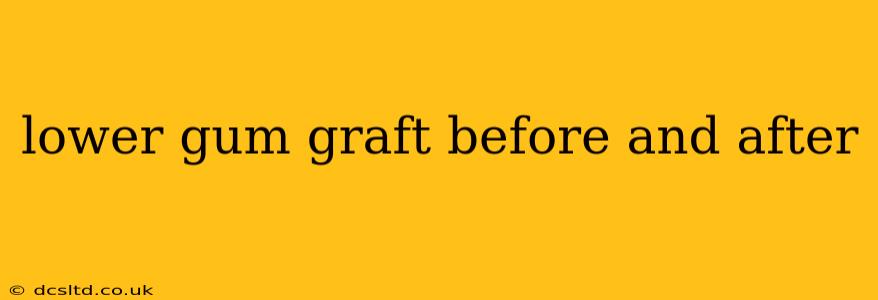A lower gum graft, also known as a gingival graft, is a common periodontal procedure designed to restore gum tissue lost due to gum recession. This recession can expose the tooth roots, making teeth sensitive to temperature changes, potentially leading to further bone loss, and impacting the overall aesthetic appearance of your smile. This comprehensive guide will explore the before and after aspects of a lower gum graft, addressing common questions and concerns.
What Does a Lower Gum Graft Involve?
Before the procedure, your periodontist will conduct a thorough examination to assess the extent of gum recession and determine the best grafting technique for your specific needs. Several types of grafts exist, including free gingival grafts, connective tissue grafts, and pedicle grafts. The choice depends on factors such as the amount of gum tissue needed and the location of the recession.
The procedure itself typically involves numbing the area with local anesthesia. Then, the periodontist will carefully harvest a small piece of gum tissue from another area in your mouth (often the palate) or, in some cases, utilize a synthetic graft material. This graft is then precisely placed over the exposed tooth root and sutured in place. The healing process takes several weeks, during which you'll need to follow specific post-operative instructions from your dentist.
What Does a Lower Gum Graft Look Like Before and After?
Before: Before a lower gum graft, you'll likely notice significant gum recession, exposing the tooth roots. This can lead to a longer-looking tooth, increased sensitivity, and potentially a less aesthetically pleasing smile. The area might appear slightly inflamed or irritated.
After: The immediate post-operative period will show some swelling and discomfort. However, as healing progresses, the grafted tissue will integrate with the existing gum tissue. The after photos typically show a noticeable increase in gum tissue, covering the exposed roots and creating a more natural-looking gum line. The sensitivity often significantly reduces, and the overall aesthetic improvement is substantial. The final result is usually seen after several months as the tissues completely heal and settle.
How Long Does it Take to Recover From a Lower Gum Graft?
The recovery time following a lower gum graft varies depending on the individual and the complexity of the procedure. However, you can generally expect some discomfort, swelling, and minor bleeding for the first few days. Stitches are typically removed within a week or two. Full healing and integration of the grafted tissue may take several months. Your periodontist will provide specific instructions on pain management, oral hygiene, and post-operative care to ensure optimal healing.
What Are the Risks and Complications Associated with a Lower Gum Graft?
As with any surgical procedure, there are potential risks and complications associated with lower gum grafts. These include infection, bleeding, numbness, graft failure, and pain. However, these complications are relatively uncommon with experienced periodontists. Open communication with your dentist about any concerns before the procedure is crucial.
How Much Does a Lower Gum Graft Cost?
The cost of a lower gum graft varies depending on several factors, including the extent of the recession, the type of graft used, the dentist's fees, and your geographical location. It's important to discuss the cost with your periodontist before proceeding.
What is the Success Rate of a Lower Gum Graft?
The success rate of lower gum grafts is generally high when performed by an experienced periodontist. However, success depends on proper patient compliance with post-operative instructions and good oral hygiene.
How Long Do the Results of a Lower Gum Graft Last?
With proper oral hygiene and regular dental check-ups, the results of a lower gum graft can last for many years. Maintaining good oral health habits is key to preventing further gum recession.
This information is for general knowledge and does not constitute medical advice. Always consult with a qualified periodontist to determine the best treatment plan for your individual needs.
